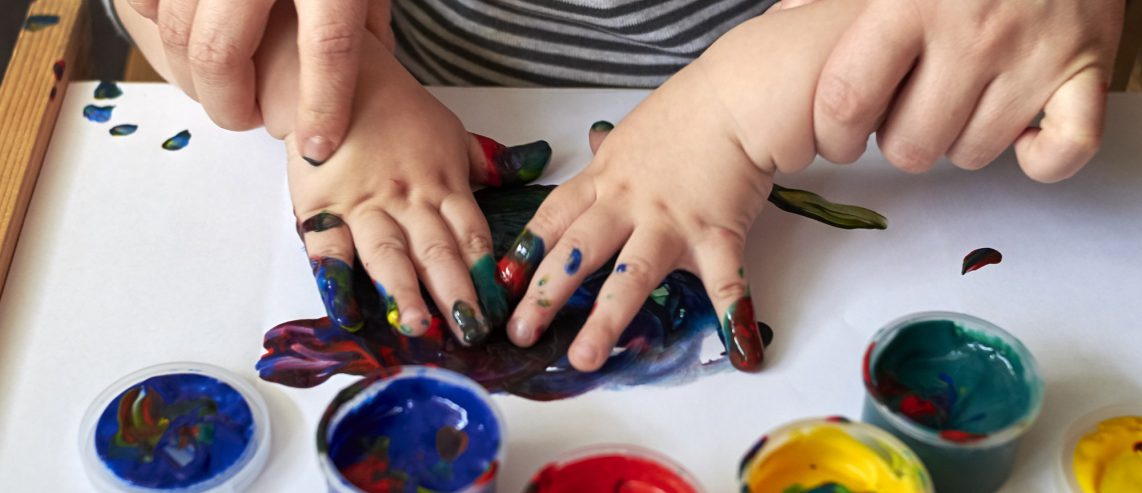Making mud pies, finger painting, splashing in water? While play might seem like it’s just for fun, for babies, toddlers, and older children, it is much more than that.
Sensory play is any activity that stimulates at least one sense. Babies and children learn about the world around them using not only the 5 commonly known senses: sight, touch, hearing, taste, and smell. They also use other lesser-known senses, including their sense of balance, self-awareness, and movement.
The benefits of sensory play are many because these activities help children make important connections in their brains. It also lets them learn in developmentally apt ways.
For example, babies honing their fine motor control might pinch, squeeze, and pull fluffy blankets with ribbons attached. Older children might sort rocks by color or size.
Sensory play also has emotional and self-regulation benefits. When children engage in sensory play, they’re in control. They can decide how often they bang a drum or whether they press Play-Doh with a finger or fist, for example.
This not only gives them a sense of power and confidence but also lets them learn at their own pace, without stress. For this reason, sensory activities are calming for many children.
Want to help your child engage in sensory play? The good news is that young children naturally gravitate toward it. You simply have to offer some materials, demonstrate ways to engage with objects around them, and let the learning happen.
Never Miss a Beat!
Subscribe to Our HealthBeat Newsletter!
Thank you for subscribing!
You can now select the specific newsletters you'd like to receive.
You are already subscribed.
Subscribe to more newsletters in our email preference center.
Sorry, an error occurred. Please try again later.
Get Healthy Tips Sent to Your Phone!
Sensory Activities for Babies
Nature walks are a great way to engage babies’ senses. They love to gaze at leaves that dance in the wind and study the contrast of shadow and light.
You can also place your child on their tummies or seated on grass. This way, they can pull at the grass and feel its texture.
Try playing classical music or children’s songs to stimulate your child’s sense of sound. Give them a rattle or xylophone so they can experiment with making their own music while honing their fine motor skills.
Sensory Activities for Toddlers and Preschoolers
Although most parents learn as children not to play with their food, research shows that playing with food actually has benefits for toddlers.
In one study, 3- and 4- year olds got to play with food, including blueberries, tomatoes, and spinach. This group was more likely to try eating these foods than children in the other study groups who just talked about the foods or engaged in non-food sensory play.
Sensory bins are another hit for toddlers. Simply get a large bin and fill it with sand, rice, water, or another dynamic material that your child can scoop, grab, or pour. An outdoor sensory table made with a sensory bin placed on a smaller table outside means less mess to clean up.
Sensory Activities for School-Age Children
At all ages, nature is your friend. Nature not only calms children but also encourages them to engage their sense of balance and coordination. They can walk on logs or leap from stone to stone, for example.
You can also teach math and patterns with objects found in nature, such as pebbles and sticks. Engaging your child’s senses of touch, sight, and hearing can help your child grasp concepts much more than simply listening can.
The kitchen is another great source of sensory play activities for school-age children. Children love to pour and mix ingredients, so baking is a great way to bond with your child. They will be having so much fun, they won’t even realize they are learning too.
Do you have a child that feels easily overwhelmed or frustrated? They might benefit from a fidget toy or squishy putty or clay they can manipulate. This can help them focus their attention away from negative thoughts and stay engaged.
The bottom line is that sensory play has emotional, cognitive, social, and physical benefits for kids and families alike. And fortunately, opportunities for sensory play are all around you.
Editor's Note: This article was originally published on , and was last reviewed on .
Sources
Helen Coulthard and Anne Marie Sealey. Play with your food! Sensory play is associated with tasting of fruits and vegetables in preschool children. Appetite. Link
Marygrace Taylor. Sensory activities for babies and toddlers. What to Expect. Link
Stacy Thompson and Jill Raisor. Meeting the Sensory Needs of Young Children. Link
Dr. Michael Yogman et al. The Power of Play: A Pediatric Role in Enhancing Development in Young Children. Pediatrics. Link
About Pediatrics
From nutrition to illnesses, from athletics to school, children will face many challenges growing up. Parents often will make important health care decisions for them. We hope to help guide both of you in that journey. UPMC Children’s Hospital of Pittsburgh is a national leader in pediatric care, ranking consistently on U.S. News & World Report’s Best Children’s Hospitals Honor Roll. We provide expert treatment for pediatric diseases, along well-child visits, urgent care, and more. With locations across Pennsylvania, Maryland, and West Virginia, you can find world-class care close to home. We also work closely with UPMC Magee-Womens Hospital, a national leader in care for newborns and their mothers. Our goal is to provide the best care for your children, from birth to adulthood and beyond. Visit our website to find a doctor near you.

